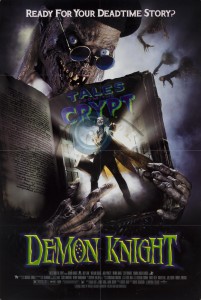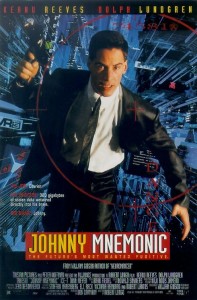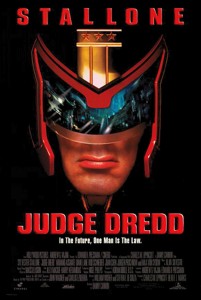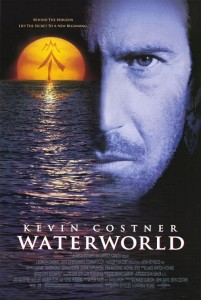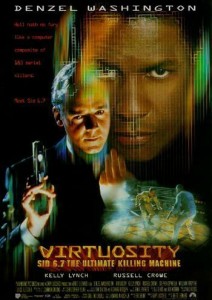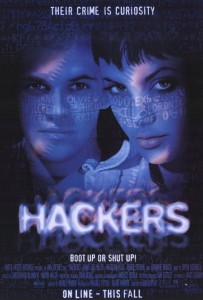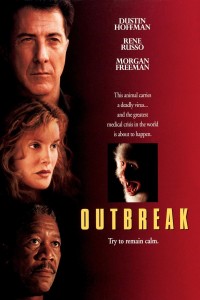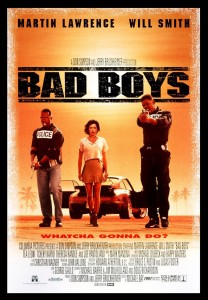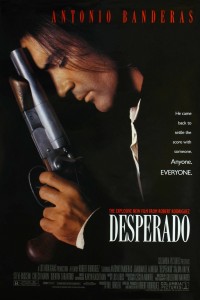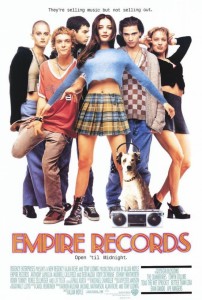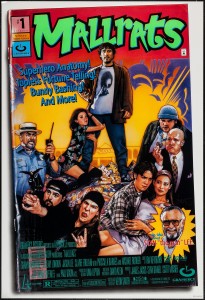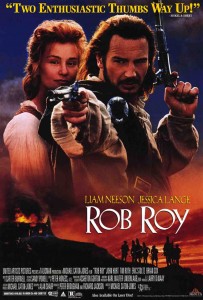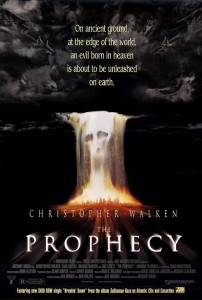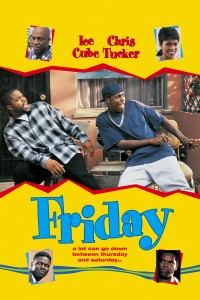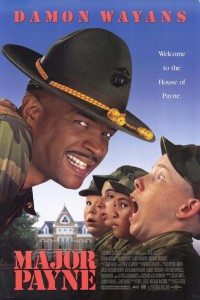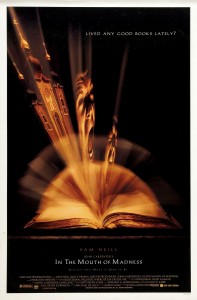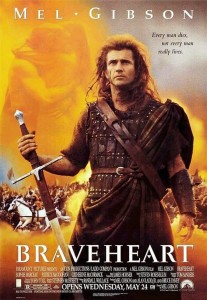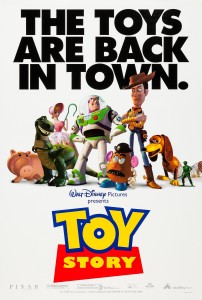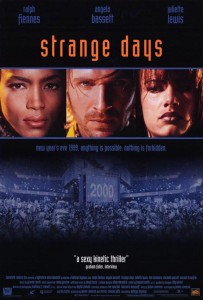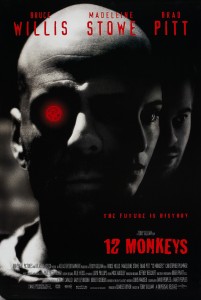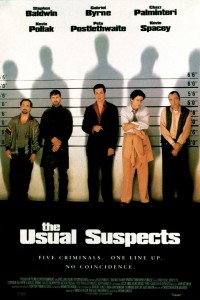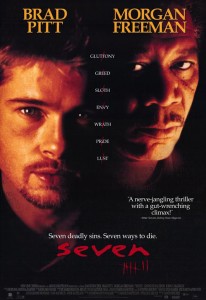1995: The Dream of the Nineties In Film
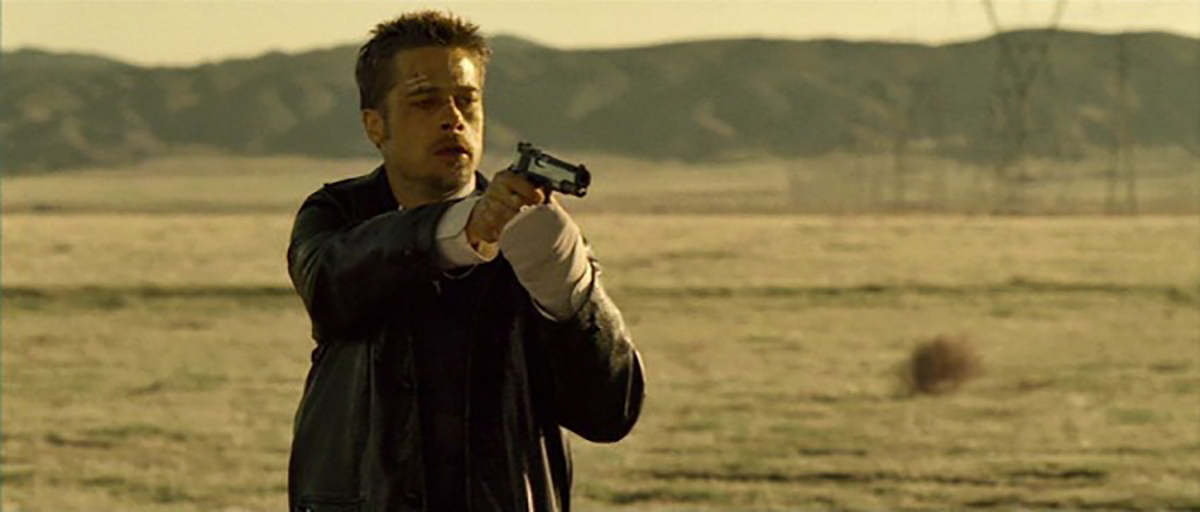
Time passes through 1995
Wow – half a decade gone by already on this project. By the time 1995 hit, I was well on my way to being a man, at least in the eyes of the law. The films kept coming though. So many films. 1995 was another great year for cinema.
We’ll get right into it this time around – I think I’ll save the ‘So Where Was I…” stuff for the cutting room floor. We all know the movies are the focus here – so, we can talk about the world and my life later to frame this year’s films.
So here we go.
The Schlock
Demon Knight
When I Saw It: 1999
What It Taught Me: Soundtrack Love
Rating: ★★★
You know… I don’t remember a lot about this film. Something about demons. A dude with a key in his hand. Not like, holding it, but the key being under the skin of his hand. A big painting with something on the other side trying to get through?
Oh yes, and blood. Lots and lots of blood.
But, for all that I blank on the movie, I remember the hell out of its soundtrack as noted in the last cutting room floor entry.
Interestingly enough, for something this schlocky there’s some names you might recognize here. I wasn’t surprised to see Billy Zane and Thomas Hayden Church in the cast. Jada Pinkett Smith was a surprise, though, as was John Laroquette.
Johnny Mnemonic
When I Saw It: 1995
What It Taught Me: Schlock
Rating: ★★★
Johnny is a Mnemonic Courrier. It’s his job to keep confidental data in his brain implants secure – even from himself. He takes on a job however that is beyond his capacity and finds himself hunted for the data he carries. The data is vital to curing a disease known as Nerve Attenuation Syndrome, and if he doesn’t get it out soon, the data will corrupt and take him out with it.
I saw this on my birthday. It was… a well intentioned gift. It was a no-brainer that I would want to watch this as it is an adaptation of a short story by my favorite author. William Gibson’s Burning Chrome short story anthology contained the story this film gets its name from. It… sort of follows the story. But it ultimately fails to deliver on a lot of fronts. The acting was bad, even by early Keanu Reeves standards (his redemption would come in 1999). The special effects… not as special as you’d hope for. The soundtrack? They got KMFDM… but nothing else of real note. This opened on Memorial Day weekend as well, the season for all-out blockbusters. This film just couldn’t hang.
It gets a few things though that scratch very particular film itches for me. Despite generally uninspired performances, they cast Henry Rollins. Not even as some random dude who they needed because Hank looks scary. He’s a doctor in this! Then there’s Dolph Lundgren as the Street Preacher. Seeing him roll up on people with a knife carved out of a crucifix shouting ‘It’s Jesus Time!’ is one of the best moments burned into celluloid ever. I wouldn’t really appreciate it until later, but Beat Takeshi is also in this film as (aurprise) a Yakuza boss. Barely speaks a lick of English. When he does, he does it phonetically by my understanding. He’s learned more since I think, but he’s so successful, he can tell directors that if they want him that bad, they’re gonna put up with him speaking in Japanese.
All three of the parts played by the actors above? Totally not in the original story. So this movie beats a stopped clock, three to two.
Judge Dredd
When I Saw It: 1995
What It Taught Me: Crazy Technology
Rating: ★★★
This isn’t quite the origin story – not at first. It goes balls to the wall within the opening credits, with Dredd doing what he does best – serving as judge, jury, and executioner as he de-escalates (read ‘murders his way through’) a Mega City One block experiencing a block war. As the story progresses, Dredd is framed for the murder of a journalist who reported unfavorably on him and is sent to a penal colony in the wretched and irradiated Cursed Earth zone. Predictably, he murders his way back to Mega City One, while also learning more about where he came from.
I have mixed feelings here as well. I like the concept of Judge Dredd, though I cannot say with full faith that I am a Dredd Head. But, even as a kid I could tell you, it was weird to see Dredd take his helmet off. The movie was a good example of how good concepts go bad because of studio choices. When you pay all that money for peak Stallone, you’re gonna get some face time.
Yet, I did like some of the tech stuff that came out of it, primarily the Lawgiver.
The reboot from recent years is a more than suitable replacement for this schlock-fest. But, it does have a special place in my heart for ‘double whammy’ alone.
Waterworld
When I Saw It: 1995
What It Taught Me: Apocalypse Building
Rating: ★★★
The Mariner (Kevin Costner) is a mutant wandering the open seas. Not that that really means much location-wise, since essentially the world is now one big ocean after an ecological catastrophe. The oceans rose drastically further than even the most liberal-swinging climatologists expected. But, if rumor is to be believed, there’s still a dry shore out there. Whispers speak of the peak of one of the world’s largest mountains still being above sea level, though most write this off as optimistic fantasy. While on the way to finding this supposed oasis of dry land, the Mariner falls under the gaze of one of the nomadic gangs with dwindling resources, the Smokers (led by Dennis Hopper).
Now, this movie gets a lot of flak. I think this is mostly because of how much money it cost not just to film it, but how much it cost to re-film it because Kevin Costner didn’t want his bald spot to show while he was underwater. When you take the budget out of the equation, what you have is an interesting (if goofy) post-apocalypse.
They handled it pretty well mostly, though there are always logistical issues I have problems with in this genre. But, all said and done, they covered mutation, resource scarcity, warlords, legends of the world before, and did all of it well considering.
The real crime here was male pattern baldness.
Virtuosity
When I Saw It: 1995
What It Taught Me: Crazy Technology
Rating: ★★★
Sid 6.7 is an artificial intelligence created for use in a proposed police training simulations in virtual reality. It’s core programming is compiled from traits of known violent criminals and psychopaths. Sid 6.7 knows what it is, and also views his existence to be a sort of prison. The programmer of the virtual spree killer has taken quite a fancy to his work though, and he decides that what the world needs is an apex psychopath made out of glass-eating nanomachines running loose in Los Angeles. Once the LAPD gets word that Sid 6.7 is loose, they send the only person that consistently beats him in VR after him: a disgraced former cop turned convict who’s been a guinea pig in the VR training project.
This is a guilty pleasure film for me. Looking back on it, I absolutely cannot tell you this is a great movie. But I was quite taken with the premise.
I don’t know where the fault lays exactly. It’s got Russell Crowe as the killer AI. That should be a point in its favor. It’s not, strangely. He overacts. Abundantly so. I don’t know if this was Crowe taking the ball and running with it, or the director asking for the excessive presentation. The effects, even for the time, were a little unpolished as well. It was the nascent age of modern special effects, so I forgive it that. Then there was the parade of B-Actors that filled out the rest of the piece including Stephen Spinella and William Fichtner. Denzel Washington (as is his way) was the powerhouse actor, and even he seemed a little dulled compared to some of his other amazingly good films.
Regardless, the idea of Sid 6.7 did take root in my mind, and the mechanics of his regenerative technology fascinated me. It made for fertile grounds for new ideas as I went on to write science fiction that focused on merging man with nanotechnology.
Hackers
When I Saw It: 1995
What It Taught Me: Nothing About Hacking (But How To Make It Look Cool), Soundtrack Love
Rating: ★★★
When you breach over one thousand systems and cause the NYSE to drop a couple points as a result, the law takes an interest. Zero Cool did just that, and as a result he got slapped with a lengthy probation on account of being a minor. He’s served his time, and the law has deemed him reformed. Of course, you can’t keep a good hacker down. The minute he and his family moves to a new town to put everything behind them, he starts up again. He finds himself lumped in with a circle of other hackers and phone phreaks of varying skill. He eventually gets himself in trouble again when the lowliest of his new friends gets caught up in some bad business. For some reason, they then don roller blades, and hack the planet for justice.
This is a big title for a lot of my friends that left an impression of sorts. It got a few things right and a few things wrong
By the time Hackers came out, I was starting to get some grasp of the internet and how it worked. I had a pretty good idea of what it could do and what it could not do, even if I didn’t know how to necessarily apply that knowledge. Hacking was (and still is) kind of a magic conceit for me. I know now that most hacking isn’t really even done by people. Code does most of the heavy lifting, with little interaction needed until someone decides to use a little social engineering to get what they want. This film had both the programming part as well as the social engineering. Zero Cool was basically a fictionalization of a guy named Kevin Mitnick, a real world hacker.
What it did not do was faithfully represent what it looks like to hack. Then again, if the producers of the film did opt for the real deal, the movie would take forty-three days to view – maybe longer depending on the types of hacks they wanted to portray. It’s hero would have been a Russian twentysomething in his boxers, fiddling with his phone, occasionally making a call, then typing for twenty hours a day. It would not look like a bunch of kids on roller blades, sitting in front of screens while cool special effects happen.
It did however have three great soundtracks though. I owned two but had them stolen from me before I learned how to rip CDs.
Somewhere in the Middle
Outbreak
When I Saw It: Circa 1996
What It Taught Me: Biological Horror, Government Conspiracy
Rating: ★★★
Outbreak was a science thriller about a virus discovered and curated by the United States government in the 1960’s. After a resurgence of the disease in Africa, it is inadvertently brought back to America where it is transmitted by a monkey to a small town. The CDC descends on the town in the hope that they can stem the tide and find an antidote.
Before I saw this movie, I had seen the miniseries of The Stand (1994) by Stephen King. I had also seen The Andromeda Strain (1971). So the horror of the biological had started to creep into my life by the time Outbreak was released. Both works showed you the ravaged bodies of those affected by its own deadly disease. Outbreak though… This was the first time I saw something that was so up close, so carefully curated to the screen. This wasn’t a broad stroke presentation. It showed the very ugly reality of a terrifying disease with no need to worry about TV censors.
Additionally, Ebola was something we were just learning about on a world stage. Outbreak took something that was very real, then took a shot at portraying what it would look like if an Ebola-like, hemorrhagic fever hit an American population.
Lemme tell you, that shit was terrifying.
This was also contemporary to the rise of government conspiracy films and television shows. The X-Files had been going on it’s second or third year by this point. Looking back, trust in the government was shaky at best without fictionalization. The generation that had grown up with Watergate and was now making their own films were insinuating government plots behind everything, and this film was no exception.
Bad Boys
When I Saw It: Circa 1996
What It Taught Me: Contemporary Action Film Formula
Rating: ★★★
Mike (Will Smith) and Marcus (Martin Lawrence) are two loose cannon cops in Miami. In one of their more recent adventures, they come to the aid of Julie (Tea Leoni): a witness to a killing that would implicate a local heroin dealer. Despite their bad reputation, she tells the Miami PD that the only way she’s going to testify is if Mike and Marcus guard her. Explosions and car chases erupt as the titular Bab Boy cops do everything in their power to protect Julie and take down Evil McHeroin’s cartel.
Before Bad Boys, The modern action film’s DNA was delivered in phases. Wikipedia says that the conventions most of us recognize in Action Movies today started in the late-Sixties and early- Seventies. Films like Bullit (1968) or the French Connection (1971) paved the way initially, and then in the Eighties we all saw the breakout that rewrote the template. Die Hard (1988) hit us all as hard as it could upon its release. After that, I think it’s fair to say nothing was the same. The bar was significantly raised for any action flicks after it. But, in 1995, the template got re-written yet again by Michael Bay’s Bad Boys. It’s up for debate if the bar was raised or lowered in comparison to Die Hard if you ask me – but this was still a lot of fun to watch.
It had a lot of the old tropes. Cops on the edge. An unreasonable witness to forward the plot. An army of well armed mooks coming to gun for our heroes. Drugs. Titillation. Hundreds of rounds of ammunition and a ton of explosions. God, the explosions. Explosions came to be the drama in themselves. Or, that’s what Bay believes Drama is.
What else was different? Well, there’s the obvious: Two black men taking the leading roles. Will Smith had exploded onto the film scene to fantastic success, and Martin Lawrence was tapped to be the funny man in the flick (though Smith does admirably himself). I didn’t really notice at the time how much of a big step that was, though in retrospect it seems obvious. While black actors had been prominently featured in mainstream films, I can’t recall too many films to feature two black leads that weren’t also made by African American directors or by the productions caught up in the Seventies’s wave of Blaxploitation.
The other thing that happened was Michael goddamned Bay’s exploding career. He launched many new flicks off the back of this one (we’ll get to some of them in later entries). Bad Boys did amazingly well at the box office (it made seven times what it cost to produce) with a great, though not record-breaking, first-week take. This lead to more derivative films being released by Bay on the tail of Bad Boys, each one adding to Bay’s legend of explosions over plot or continuity. For good or ill, the Action film format was cemented close to something we have today.
I eagerly wait the next step. It’s been over twenty years and we need a new formula now more than ever.
Desperado
When I Saw It: Circa 1997
What It Taught Me: Over the Top Gunfights
Rating: ★★★
Sometimes, when a man has been wronged so badly that he has nothing else to lose, he puts automatic weapons in a guitar case and kills a whole lot of people. That’s more or less what happens to Antonio Banderas’s character in Desperado. He is on a quest for revenge against the men who killed his lover, and he’s not particular about how many bodies he leaves in his wake along the way. At least, that’s what I remember.
Desperado was based on a great little action flick named El Mariachi (1992) on an independent shoestring budget, filmed by a then unknown Robert Rodriguez. El Mariachi slipped by my radar, but Desperado was almost impossible to ignore once the Hollywood machine remade it with relatively big name stars. Antonio Banderas was only known to me from Interview With the Vampire, but I knew of Selma Hayek by watching From Dusk Til Dawn (1996), and of course I could identify Steve Buscemi, Cheech Marin, and Quentin Tarantino who all had parts.
The action was fast paced, ruthless, and relentless. Once the shooting starts, it doesn’t stop. I was rather in awe of this film at the time, though I haven’t seen it in years since. The part that remains clearest in my mind is the scene where Quentin Tarantino tells a joke about a guy who pisses all over a shitty bar. For all of the action I witnessed… it’s faded. But, for its time, it was great.
Empire Records
When I Saw It: Circa 2002
What It Taught Me: Soundtrack Love, Damn the Man
Rating: ★★★
The Empire Records music store is on hard times. After saving up enough money to stall the inevitable, store owner Joe (Anthony LaPaglia) realizes that his well-meaning employee, Lucas (Rory Cochrane), has run off with his nest egg to Atlantic City. Lucas blows a winning streak after pressing his luck, and now, the store will no longer be able to remain independent. This comes as a crushing blow to the store’s misfit employees, who must deal with the shop’s impending rebranding into a corporate chain shop. On their last day as Empire Records employees, things go off the rails quickly. A race to save the store begins and a lot of other stuff happens too.
Many of my friends no doubt would put this way up in their lists, though it has a little bit of a lower rating for me. I missed this film in its cinema run somehow. If you’d have asked me for a rating at the time I watched it, it would have been higher. My girlfriend at the time loved it because she worked in a little indie record store on campus so, I might have been biased then.
I’m not as biased now. And since I’ve aged some since, this film rates somewhere in the middle. It had a pretty good cast. You have, Liv Tyler, Renee Zellweger, Anthony LaPaglia, and Rory Cochrane. It had a feel-good underdog story with several other subplots. More than anything else though, it had a soundtrack that was authentic for its time (see the earlier entry for 1994 here for more about Nineties soundtracks). It had the Gin Blossoms, The Cranberries, Toad the Wet Sprocket, Cracker, and Better Than Ezra. All acts that were just fresh enough and turned out to be evocative of the decade. Listening to the soundtrack alone is worth the time, even if the coming-of-age, angsty, outsider plots are laid on a little thick once you’re no longer in your twenties.
Mallrats
When I Saw It: 1995
What It Taught Me: Timing, The Art of the Vulgar
Rating: ★★★
Mallrats is essentially a story about two slackers who are trying to win back the hearts of their ex-girlfriends who broke up with them the morning the tale begins. They proceed to go where any other twenty-something goes when spirits are low – the mall! Wackiness ensues as they get into misadventures while winning back their lost loves.
Kevin Smith had been launched to stardom with his 1994 release of Clerks. Within a short timespan, he put together Mallrats, another film set in the View Askewniverse – a tangle of separate narratives linked together by continuity and his modern day Rozencrantz and Guilderstern (Jay and Silent Bob). It had a cast of mostly B-Listers at the time it was shot, some of whom went on to have pretty good careers. It starred Jason Lee, Jeremy London, Claire Forlani, and Joey Lauren Adams. It also had a couple of well known folks too – Ben Affleck, Shannen Dougherty, and Michael Rooker. Stan Lee even has a cameo.
For me, it doesn’t outshine Clerks (an argument I frequently have with die hard Mallrats fans), but it does continue to lay down some of the great comedy that Smith is known for writing, as well as his hallmark vulgarity. The stinkpalm. Stereogram angst. The status of the Easter Bunny’s existence. Flatulence mid fellatio. Mystical third nipples. And, of course, Cousin Walter.
Rob Roy
When I Saw It: 1995
What It Taught Me: Vengeance
Rating: ★★★★
The grand thrust of Rob Roy is that Rob Roy MacGregor (played by Liam Neeson) leads an insurrection after he is sorely taken advantage of and his wife is raped by a scurrilous nobleman. He ain’t having none of that, so he begins a series of brutal and tragic events (because, Scotland) where his vendetta is carried out in a most gruesome fashion, and the wicked are toppled.
You know, here’s a funny thing. My parents were, as noted before, restrictive on films for the most part while they had a good handle on my comings and goings. Things slipped through the cracks of course. Most things, they were on top of. But, sometimes, they threw their restrictions to the wind on account of ‘culture.’ This was one of those films. It is loaded to the gills with rape, murder, theft, vendetta, and general blood, guts, and nifty bone-snapping. I dunno culture was an appropriate ‘out’ here.
The particulars of the film are hazy to me, save for one. The denouement results in a spectacular display of gore, of which I still recall vividly even now. You should really see it for yourself. Impressive stuff.
The Prophecy
When I Saw It: Circa 1996
What It Taught Me: Just the Right Amount of Creep, Theological Horror
Rating: ★★★★
The Prophecy centers around a battle between angels and demons to find a special human soul. This soul will break the everlasting stalemate between the forces of heaven and hell for which ever side can come to possess it. The Archangel Gabriel (Christopher Walken) wants it because… well, he’s kind of a dick, and doesn’t take a favorable view on humanity. Lucifer (Vigo Mortenson) wants it because he can use it to get back into Heaven and take vengeance on the creator that spurned him. Detective Daggett (Elias Koteas), a former seminary student who had a lapse in faith, is caught in the middle of all this now that he’s a cop protecting this crucial soul.
This hit my VCR in college during my first quarter. By this time I had become more than a little fascinated by the biblical apocalypse after reading the RPG rules for a game called The End. This came along a bit after reading it through. It’s a fantastic take on apocalypse and has a pretty good cast between Walken, Eric Stoltz (the Archangel Simon), Mortenson, and Koteas.
Now, to say a movie is creepy because it has Christopher Walken in it is moot, but he’s particularly good in this one. He provides just that right amount of creepiness between presenting the secret of why we have a dent on our upper lips, as well as the exact and gruesome nature of angels’ acts. What pushes it over to being exceptional is actually the portrayal of Lucifer, and a single line that is uttered by Detective Daggett. Lucifer points out the true nature of Hell, and Daggett has, quite possibly, one of the most chilling lines of dialog about why people might not want to meet an angel.
Quick tip though: you can stop here. For whatever reason, Walken signed on for a bunch of sequels that were… less than sterling. Nothing says quality like direct-to-video.
Friday
When I Saw It: 2002
What It Taught Me: Expanded Horizons, A Movie Can Be More Than One Thing
Rating: ★★★★
Craig (Ice Cube) has just been fired on his day off. His friend Smokey (Cheris Tucker) decides that his normally sober friend could use some cheering up of the herbal kind. However, the weed that is proffered is part of a dwindling supply – a supply Smokey was supposed to sell, not smoke. Events unfold as the consequences of Smokey’s decisions and the local neighborhood drama grows.
I think I finally saw this one while I was working at Borders Books on the recommendation of an ex-girlfriend. This movie would have fallen under the category of non-approved films at its time of release. To be honest though, it didn’t really ping on my radar. I wasn’t really introduced to hip hop, and rappers turned actors seemed to be about as good as rockstars turned actors (Freejack, anyone?).
I did get over the hump when it came to my preconceptions of the film. The movie is great and stands the test of time. First of all, Ice Cube is actually pretty good at acting, which I didn’t account for on my first viewing. Less surprisingly, it’s script, also written by Ice Cube, is great. This is also early Chris Tucker stuff, before he really started to get big. The character Deebo is a favorite as well. While I really first remember him as the President of Earth in The Fifth Element (1997), this film adds to my love of Tony Lister.
It also wouldn’t be inaccurate to say that this was my first black produced film. Like any other suburban white family, there was a bit of fear of the hip hop scene on the part of my parents. I like to think that this is not on account of any racism on the parts of my folks who didn’t subscribe to that sort of thing. My sis and I were raised better than to discount things based on culture. Likely it was more the glorification of sex and violence that gangsta rap was espousing that would have turned my parents away from getting to view this film in their house.
This movie also defied a strictly comedic model. The stakes are real in several scenes, such as Felicia’s assault, the people sent by Big Worm to kill Smokey for smoking his allotment of sellable weed, and the ultimate confrontation between Craig and Deebo in the last few minutes of the film. This isn’t really just comedy – this is a fair (if somewhat exaggerated and lampooned) depiction of the black experience in California at the time. If Ice Cube’s depiction through the lens of that time doesn’t qualify as the stuff of drama, I don’t know what does.
Major Payne
When I Saw It: 1997
What It Taught Me: I Don’t Know, But I Like It
Rating: ★★★★
Major Payne, played by Damon Wayans, is an elite soldier. Name a black op and he’s been on it. Wherever there is a threat to America, you’ll find him armed to the teeth. But, after a dangerous mission out of country he finds out when he returns that there are no more enemies that America needs killed any longer. Diplomacy has become the path to the future and he finds himself relieved of duty. Out of desperation, he takes on the role of an instructor at a military academy for young children. He goes on to find a new challenge: dealing with a force that he’s not allowed to kill. You know, children. It’s now his job to bring them some much needed discipline and to be a good role model. Things get… interesting for both sides.
I watched this movie under protest. It seemed dumb. It is dumb. While ‘In Living Color’ (1990-94) had left a great experience for my cousins and me, the Wayans were starting to get a little stale. But, it was rented by a friend, and we decided there were worse ways to spend an afternoon.
Holy. Shit. I can’t quite bring myself to put it into the personal blockbuster category as it is a relentlessly goofy comedy (these tend to rank poorly in my movie watching categories). But it’s a very close call.
The things Major Payne says and does (to and in front of these kids) are amazing. My favorite bit in the film is when a five year old child, withdrawn and a little scarred emotionally, comes to Payne with his fear of a bogeyman in his closet. Payne, having been told by the kids’ guidance counselor to be more sensitive, marches the kid into his room. Payne points at the closet and asks: “He in there?”
The result is priceless when the kid confirms the location of the bogeyman. I couldn’t stop laughing for a good couple minutes after that.
Ultimately, this was a movie that I did not expect to be half as funny as it actually was. I heartily recommend this film for anyone in desperate need of a good laugh.
Personal Blockbusters
In the Mouth of Madness
When I Saw It: Circa 1997
What It Taught Me: How To Break a Mind
Rating: ★★★★★
Sutter Cain, a famous author who is about equal parts Stephen King and H.P. Lovecraft, has gone missing. His publishers are very concerned. Cain was to deliver them his Magnum Opus, a work called ‘In the Mouth of Madness.’ Fearing the worst, they send out an insurance investigator (Sam Neil) to look into his disappearance and determine if there’s any foul play (and of course to collect the insurance if something has gone wrong). The investigator and a representative from the publisher go out to find him, only to discover they have driven into the fictional setting of Cain’s novels. The horror unfolds, slowly at first, as they realize that Cain is not just planning on releasing a new best seller – his new book will literally drive his readers mad and usher in a new age of terror.
This movie would have passed me by had I not seen it on the shelf at the Blockbuster Video I briefly worked for. I had it in my hand to reshelve from the previous day’s returns. I inquired into if it was any good. Some of the other folks working with me there recommended it. This was in my early foray into horror – I’d only recently watched the original Night of the Living Dead (1968) and was new to this genre in movie format.
This film gripped me from the start. I was no stranger to the works of H.P. Lovecraft by that point. I’d read Shadows Over Innsmouth, The Call of Cthulhu, and The Rats In the Walls amongst other horror tales by Lovecraft. I remembered that if the film wanted to capture the essence of the Lovecraftian it would take a lot of work to make it look convincing. It was an ambitious film for its time. Special effects were blooming to be sure, but they were a highly expensive proposition at that point. What we take for granted now was very difficult then. So they worked with practical effects. They did things as simple as lens replacement (“Did I ever tell you that blue is my favorite color?”) to the abhorrently grotesque (the scene where the publisher rep twists and contorts into a mythos warped horror still makes me cringe).
The portrayal of madness was also insidious. The crux of the film hinges on the concept that if enough people believe in something strongly enough, it becomes the dominant paradigm. As Cain points out, more people have bought copies of his books than there are copies of the bible. As the books spread, so does his paradigm, and it takes root in a very real and grotesque way. The apocalyptic end of the film still chills me to the bone.
Braveheart
When I Saw It: Circa 1996
What It Taught Me: Scotland Rocks, Medieval Brutality
Rating: ★★★★★
Braveheart is a biographical film that covers the life of William Wallace, a Scottish patriot who led a revolt against England in the 1200’s. It is largely focused on his struggle against Edward the Long Shanks, a brutal English monarch who instituted policies that greatly injured the highlands and its people. As noted earlier, don’t buy your history from Hollywood. The film is a very loose representation, more focused on the blood and terror of the battlefield than political history or accurate representation of Wallace, his allies, or his rivals.
It was on a trip to Scotland that I both learned about the film and was told our family has a little Scot heritage in it. So it was an experience for me to learn a little more about the country and its history. I actually got to see the places where the film’s many battles played out, particularly Stirling Castle. I developed a thirst to learn more about the country. To some degree, this film helped me learn a little bit more (with careful guidance from my father, an actual history buff).
Additionally, you’ll find some amazing battle scenes here. The film revels in the sheer brutality that warfare brought in the middle ages. No punches are pulled, and some more than unlikely acts of butchery are gorily depicted. I have little doubt that this movie put the seeds of gruesome filmmaking into Mel Gibson’s head that would flower later in The Passion.
Toy Story
When I Saw It: Circa 1996
What It Taught Me: Texture and Lighting Are Everything
Rating: ★★★★★
Toy Story operates on the premise that our toys are actually alive. They identify with their owners for good or ill, and while they are in use, they suppress their hidden lives. When their owners are away the toys live their own unique lives. Andy’s toys are no exception. Woody the Cowboy (Tom Hanks), a simple toy with a pull-string voice box, runs the toybox as a leader. When the super-cool, battery-powered spaceman, Buzz Lightyear (Tim Allen), joins the toybox though, everything changes. Andy favors Buzz now among all his toys, and Woody takes offense. In a plan to regain Andy’s affection, Woody gets both himself and Buzz separated and ultimately lost. They must now work together to return to Andy’s room, and hash out a friendship along the way.
I missed this one completely in theaters, only discovering it in my first quarter of college. It was the darling of every student in my major: Computer Animation. As required viewing I saw it in the classroom and immediately went to Tower Video to acquire my own VHS copy. It was more or less love at first sight.
In and of itself, it’s a heartwarming story. Love and friendship, fear and discovery, lessons learned and futures forged. All good stuff. But, I’m not even gonna get into the story here. Because this is all about high tech nerdery for me.
This film was basically the computer animator’s playbook in 1995. While 3D animation had been in use since the early eighties, it never looked quite right. Sure it had its charm, but it always lacked something. This film and Jurassic Park (1993) really broke through that wall. Every Pixar film has not only the goal of telling a great story, but also to advance their craft in a new direction. The key element they explored in Toy Story was texture and lighting. It wasn’t enough to have the right colors or the modeling in place (though they did). What they wanted to show you were completely accurate representations of all of the toys their audience would be familiar with. Mr. Potato Head is an orangey-brown, but there’s also a kind of sheen and surface flow to him. With the right texture mapping and lighting, you could count the raised scales on Rex’s outer shell. You could see the little imperfections and gouges on all of the Army Men. Everything was simulated in the right lighting and with the right mapping to be representative of reality. It was an amazing feat, and that alone showed me the depth and breadth to which my work could aspire.
Strange Days
When I Saw It: 1995
What It Taught Me: Cyberpunk
Rating: ★★★★★
In the future of 1999 (God, I love typing things like that) a technology has emerged that allows you to record your own sensorium for later review. While this technology was originally deployed to law enforcement divisions for a new kind of wire for officers, the technology went to the black market where it is used to record explicit, racy, and criminal behaviors. It is highly addictive as well, leading to a huge problem in trafficking the resulting recordings called ‘clips.’ Lenny Nero (Ralph Fiennes) is a disgraced L.A. cop from the vice squad. He’s a clip dealer working hustles to make ends meet. He doesn’t have many friends left save for a buddy from the force (Tom Sizemore) and a bodyguard he helped while still on the beat (Angela Bassett). When an old friend leaves a damning clip of a recent atrocity for Lenny, he becomes the target of what looks like a wide conspiracy in the LAPD.
I went on a date to see this movie. I was probably more into it than she was, but there was good reason. As noted before, cyberpunk hits me in all of the feels. There’s relatively few cyberpunk films (or at least a rare few good ones). But, this one ranks way up there.
It’s a noir story at its heart, but its cyberpunk trappings – the clips and their illicit markets – are really what makes the film stand out. They put in just enough technobabble and the abuses of new technologies to give it the cyber part. The punk part comes into play when looking at a near future in which corruption, disaster, and crime have ravaged America. It’s ‘punk to the core, and easily stands up along other cyberpunk masterpieces such as Robocop (1987) and Blade Runner (1982)
12 Monkeys
When I Saw It: 1995
What It Taught Me: How To Break a Mind; Terra Cognita
Rating: ★★★★★
This Terry Gilliam film follows Cole (Bruce Willis), a man who is either mentally ill, a time traveller, or both. He believes he is from a future in which a deadly virus has wiped out humanity save for a few who have taken shelter deep underground. The masters of his of future society have developed time travel to avert the crisis, and they send expendable inmates from their prisons back to do research. Cole’s role is not to intervene, but to collect enough data so that the precise point the virus is released can be targeted, then mitigated. The technology however is flawed and wildly inaccurate. Cole skips between the future, 1990, 1996, and 1916 (briefly), and through the process comes to believe that he may be responsible for the creation of the disease.
Gilliam, per usual, develops a world so plausibly bonkers that you cannot help but be caught up in it. Madness reigns supreme in several different points in the timeline through a time loop of massive scale. Either everyone from the future is insane from living underground, or something about time travel simply unravels people. Through an twisted lens, Cole meets all of the primary actors of the plagues creation and release. He targets Dr Goines (Christopher Plummer), the scientist believed to have created the virus, his deranged son Jeffrey (Brad Pitt) who is believed to have released it, and eventually a lab assistant (David Morse) with an apocalyptic bent. then there’s Katheryn Reilly (Madeline Stowe) a psychologist who tries to treat Cole in 1990 only to fall into Cole’s sway in 1996. Reality and possible mental disorders begin to blur as both Reilly and Cole try to parse out what is really going on.
There’s additionally something wonderful about seeing someplace you know on film. I went to see this movie after touring a college campus in Philadelphia the very same day. Seeing the city I had just walked through covered in apocalyptic levels of snow and populated only with wild animals gave me chills. I know all of the primary locations they shot at because I lived in Philadelphia for four years, close to the time the film was shot. I remember the John Wanamaker building, City Hall, the Schuykill Express view they show toward the end of the film. I know all of the news casters you see on all of the local channels throughout. They spared no expense to shoot where the film was taking place and it made the film all the better.
The Usual Suspects
When I Saw It: 1997
What It Taught Me: Crime
Rating: ★★★★★
The Usual Suspects hinges on the testimony of Roger ‘Verbal’ Kint (Kevin Spacey), the only surviving member of a group of criminals killed on a boat in a California port. His testimony unravels a very long, very twisted narrative of how he met a bunch of other crooks after being brought in for a line up and find themselves in a position to work together against the people who put them there. As they enact this plan, they become ensnared in a larger scheme with more notorious criminals above them. Eventually, they find they have all been manipulated since their meeting to work the will of a criminal underworld bogeyman. That man is Keyzer Soze. His name is legend, as is his wrath. Criminals view him as no less evil than the devil himself. No one crosses him. No one knows what he looks like. Some criminals don’t even believe in him – but they say that really quietly. When he eventually comes knocking for Verbal’s crew, things go badly.
I find this to be one of the more unlikely entries in my film repertoire. I’m typically not one to go for stories set in conventional reality. When it comes to my favorite films, I tend to go for the fantastical, the macabre, the odd, and the apocalyptic. I do however find the occasional straight crime story to my liking. Well, in this case, kind of straight.
This story really goes through its paces with a great and looping dog-and-pony show. Verbal’s group travels to new places, make friends and enemies, and enact revenge as they are preyed upon. The story zigs and zags. For every step forward, the men in the crew find themselves with fewer and fewer options until the events on the boat unfold and the ultimate truth of Keyzer Size is finally revealed. The movie keeps you guessing right up until the end, which is one of the best shot scenes in crime drama.
The cast was also a wonderful mix. With Kevin Spacey, Benicio Del toro, Kevin Pollack, Stephen Baldwin and Gabriel Byrne feature as the criminal team, Chazz Palminteri is the cop working to uncover the fate of Keaton (Byrne), and Pete Postlethwaite serves as the devil’s right hand man.
Seven
When I Saw It: Circa 1996
What It Taught Me: Everything
Rating: ★★★★★
Oh man. Oh man, oh man, oh man. I’ve been waiting for this entry and I’m going to break format here. This is in the running for a three-way tie for favorite movie. I love this movie. Every time I write a scene where there’s an urban hellhole, this movie is channelled hard. Whenever I need to think up of a crime brutal enough to grab someone’s attention, this film’s styling flows out of my hands. Whenever I need someone cynical and broken in a story, Detective Somerset starts speaking in my head.
Seven begins with a hardened and weary homicide Detective, Somerset (Morgan Freeman), arriving to the scene of a gruesome killing. While working out the scene, he meets the partner he’ll be working with for his last week on the force, Detective Mills (Brad Pitt). The crime scene is incredibly elaborate for someone who would have simply wanted a man dead. Somerset knows killings like this one have meaning. Soon enough, he’s proven correct. Another killing leads to evidence that the two killings they know of are linked. And that there will be five more. The murders each embody one of the seven deadly sins, and the killings are likely to become more brutal and personal as they close in on the suspect.
Seven is simply the best crime drama I have ever seen.
This film has it all. The macabre. Humor (if morbid). Drama. Crime. Filth. Sleaze. Even hope. Crime scene by crime scene, more grisly discoveries are made. The killer is poetic and fixated on morality in his work. Every shot simmers with tension and darkness, making a rich stew of human tragedy. It is a wellspring of dark pathos, and every so often, I ladle out a bowl of it. I savor this horrid thing, because if you’re going to write stories about the dark madness beneath the surface of life you must occasionally taste it for yourself – at arms length of course. The movie is a dark carnival of the soul that serves as a touchstone for the darker elements of fiction.
One of the great things that they accomplish in the film is the faceless city it takes place in. It’s a mad, feral place. Desperation, corruption, justice, mystery, and ever present rain permeate its streets and alleyways. No residence is in an apartment building so much as a dark warren of interconnected, yet isolated, hovels. No highrise or uptown location can really be safe. The streets are slick with oily water and blood in equal measure. There’s always someone there. Watching. Waiting for the right moment to do something truly awful. And it’s all anonymous. They never say what city they’re in. It’s all meant to blend in. It could be anywhere. Maybe it’s your closest metro, seething with darkness and apathy, waiting to swallow you whole. The place is malignant and pulsing with stories – most of them grim.
It’s fine and dark work that sings chillingly into your ear. Some people had The Silence of the Lambs to shock them. Me, I had Seven.
